| Pez Maya and Tulum |
|
[Last updated: 13-Jan-2022]
| Introduction | | | Week 1 | | | Week 2 | | | Week 3 | | | Week 4 | | |
| Week 5 | | | Week 6 | | | Week 7 | | | Week 8 | | | Mexico to Home |
I again awoke at 04:00 - bodyclock scenario! Fortunately, I managed to get back to sleep until just before 07:00, when I decided to get up. I saw an amazing sunrise at 07:13! Breakfast was at 08:45. Porridge was the main food, but as I don't like it, I had some apple and banana.
Then it was time for the new volunteers' Initiation Process to start! At 09:15, Pete, the site manager, gave us 'newbies' two presentations: The Hazards of the Reef, and Conservation Research at Pez Maya. At 11:00, Kerry (who left GVI Pez Maya a few weeks later (to go and work in Grenada)) gave us an introduction to the GVI program.
It was scheduled that us nine newbies have a swim test at 11:45, but because of the strong wind, high waves and rain showers, the activity was postponed to another day.
After lunch (which was between 12:30 and 13:30), I walked down the beach to admire, and walk in, the Caribbean Sea for the very first time! The following photos show the beach from four different positions:
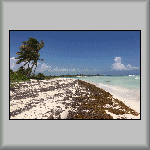 Photo MX-004 |
 Photo MX-005 |
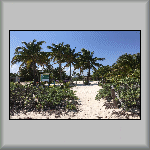 Photo MX-006 |
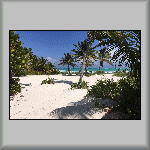 Photo MX-007 |
We continued our initiation process that afternoon. Zack told us about the diving equipment (Buoyancy Control Device (BCD), Regulators and Tanks). He was also the person to inform if we encountered any problems with any of those items. He also showed us how to refill the air tanks, using the two compressors (nicknamed Jess - the newer and more powerful one - and Sam).
After dinner, we played that 'must-have card game' (Cards Against Humanity)!
Then it was time for bed. The remining absent volunteers, who had been
away for the weekend changeover, arrived back at the base later that
evening.
Monday, 06-Mar-2017
It was a stormy night. My alarm woke me up at 06:30 for a 07:00 'Duties' (Communial and Kitting Areas) start. On my way from the hut to the communial area, I was met by the sight of a most beautiful sunrise; see Photo MX-008. Despite the wonderful sunrise, the weather was still bad, so today's diving was cancelled.
At 09:00, it was 'Kitchen Clean and Tinaco' time: Kitchen Clean. Every Monday morning, the kitchen was completely cleared and everything cleaned (walls, cupboards and floor). In addition to that, volunteers fill buckets of water (from the well), and pass them up to the staff on the kitchen roof to fill the Tinaco (a large plastic tank that supplies water to the kitchen sink; see Photo MX-009.
At 10:15, us newbies watched a DVD about Emergency First Response (EFR).
 Photo MX-008 |
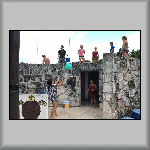 Photo MX-009 |
With the diving having been cancelled, Tommy and Emma got all volunteers playing Robot Wars - GVI Mexico style. Four teams were made up by the volunteers from each hut. One person from each team is blindfolder and positioned inside a rope ring, on the beach. Soft balls, made from socks and gloves, are thrown into the ring and the blindfolded players have to be guided by a designated team member to collect a ball and throw it towards one of the other opponents in the ring. If hit, that player is out. The game ends when there is one player left in the ring; that team wins.
Lunch was at 12:30. At 14:30, we had an EFR practical session, when we practised being the first response person. The victim could be seriously ill, but according to the (American!) video, the first response person has to say and ask "My name is name. May I help you?" before doing anything! Perhaps it is because of the American legal situation! I don't think that happens in Europe, certainly not in the UK; but I may be wrong! We just get on and attempt to help the injured person. I'm sure the British press would have a field day if every first response person started saying those words at every incident. Imagine that having to be said to every victim of, or casualty at, a terrorist attack, or a major motorway pile-up!!!
Dinner was at 18:30 and I retired at 21:00.
Tuesday, 07-Mar-2017
We had a lie-in until 08:00, as today's diving was cancelled, again, due to the bad weather. Even though, I got up shortly after 07:00 and took an early shower. [I soon learnt that it is not normal practice to have a morning shower. They are generaly taken in the afternoon, once all diving has finished.]
This morning's Duties was Grounds. This entails using plastic rakes and raking the sand, to disturb any sand flies and eggs that might be present, and also to prevent the flies from nesting. Duties are always performed before breakfast.
Between 09:00 and 09:45, we watched a video about plastic pollution, and what it is doing to this planet; especially the oceans - and those animals and fish that live in them (it was really informative!). With that fresh in our minds, we all set off for a beach clean to collect as much rubbish as we could. When we returned to base (at about 11:15), everything was weighed. Between us, we had collected about 30 kg of rubbish/plastic (including 35 plastic bottles)!
 Photo MX-010 |
 Photo MX-011 |
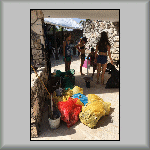 Photo MX-012 |
I had some spare time before lunch, which I used to write a few more pages of this diary. While doing so, Kathleen informed me that she and I were this week's bloggers, which we decided to discuss what to write, on Friday evening.
Lunch was at 13:00 (Spaghetti Bolognese, with the meat part of the sauce made from soya), followed by a tutorial on studying coral species.
The staff at Pez Maya ran two conservation projects: fish monitoring and coral monitoring. Before arriving at Pez Maya, volunteers are divided between the fish monitoring group or the coral monitoring group, and were requested to learn the names of the different types that are found in the region, in order to be able to monitor them.
For coral monitoring, volunteers staying for periods up to four weeks need
only learn the genus names; i.e., the first part of their scientific names.
Common coral names (for example, Staghorn and Elkhorn corals) are easier to
learn than their scientific (Latin) names (Acropora cervicornis and
Acropora palmata respectively). However, those staying longer (like
me) had to learn both the genus and the species names!
Note: It is worth noting that (for identification purposes while
learning) learning the common names was acceptable!
I wanted to be in the fish monitoring group, but I was allocated to the coral monitoring group, which meant I had to learn in excess of 50 different coral names! [This wasn't clear on the GVI web site!] However, once I had started learning about the different types of coral, I was pleased of the decision.
Corals are made up of polyps and corallites, and depending upon how they develop, defines the genus and species. Corals get their colour from single-celled algae, called zooxanthallae (pronounced zo-zan-thel-ee), that live in the polyps' tissue. They seem to stimulate or aid the secretion of Calcium Carbonate (CaCO3).
Dinner (at 18:30) was pizza, followed by a table-tennis competion. Being
eliminated early, I (along with other hut-mates) retired for the night.
Wednesday, 08-Mar-2017
My breakfast was banana, not porridge! This morning's duties was Boat, which unusually for today, entailed loading the truck with 16 air tanks. We were to go diving, but because of the weather (again), not in the Carribean Sea.
We had a Community briefing from Hector (about the school at Punta Allen), at 08:15, followed, at 08:45, by a Dive Check briefing from Hector and Liz (on how to prepare the equipment, ready for a departure at 12:30). Because of the time of the departure, lunch was brought forward to 11:45.
We departed, at 12:25, for Cenote Encantado (a fresh water lake), about 30 minutes away, in the direction of Tulum. When we arrived, we had to carry the tanks (and other accessories) from the truck to the lakeside; then it was time for a quick photo (Photo MX-013)!
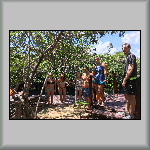 Photo MX-013 |
Before the diving started, we had to complete the swim test that was postponed from Monday! The test involved us swimming 200 metres unaided (i.e., without any buoyancy aids; for example, floats or a wet suit), followed by floating for 10 minutes. I was glad it wasn't a race, because I came last; well, someone had to! It had been a long time since I swam 200 metres unaided; and on the surface!
Then it was time to get dressed with our diving equipment: putting our diving boots onto our feet, selecting a weight belt (and the appropriate amount of lead on it; 9 lbs (4 kg)), attached the regulator to the tank, put weight belt around one's waist, and then put the BCD and tank onto our backs! There were six of us in the group I was in, led by Hector, with Liz at the rear. We had five activities to accomplish (loose and retrieve our mouth piece, remove and refit our mask, maintain buoyancy for 30 seconds, Out of Air procedure, and remove the air line at the surface), which we all did, although I made a mistake of inflating my BCD during the Out of Air procedure, which two of us had to (sucessfully) repeat. Once completed, Hector led the way into the 'abyss' for a fun dive, where we reached a depth of 7.1 metres.
We completed the dive after 44 minutes, for which I felt very pleased with my effort! We left Cenote Encantado at 16:00 and arrived back at Pez Maya thirty minutes after.
Time for a shower before dinner at 18:30. At the after-dinner briefing,
Pete informed us that we will not be diving tomorrow, due to the prolonged
bad (very windy) weather. Liz then sat with the four of us to discuss
today's diving. I said that I was pleased with my efforts, as that was
the first dive I had done for about 8 months.
Thursday, 09-Mar-2017
This morning's Duties was Kitchen, which was pancakes! Due to our inexperience in quantities, additional batter was required!
Because of excessive use of water in the kitchen, the staff had to top-up the Tinaco (again). Once that was completed, Kerry gave us a presentation on coral, where we were shown the different types of coral. [Click to show/hide the first list of corals to learn!]
It was during this presentation that we were told that those volunteers staying for 4 weeks need only learn the first scientific (genus) names, while those staying longer, need to learn both scientific (the genus and the species) names.
At 10:30, Pete gave a presentation about marine plants.
Sophie asked me if I would be the Hut Rep for the week. "Yes" I said. The four reps (one per hut) went, with Kerry, and sat on the beach to discuss any issues that there might be within the huts; but there weren't any. The reason (I think) was because a large percentage of the volunteers were newbies, and we were still familiarising ourselves with the new environment. After the meeting, I returned to the kitchen to help prepare lunch.
At 14:00, Tommy gave a presentation to everyone about 'The Cove' (Mexico, the Yukatan Penisula, and Pez Maya), followed, at 15:15, by a presentation on the birds of the region. [It reminded me of the bird surveys that I took part in Botswana last year.] I had seen some Frigatebirds flying over and around the beach, but I didn't know what they were, until Tommy mentioned it during his talk.
Emma A conducted a workshop on knots at 16:00 (the bowline, the sheep bend (U.K.: sheepshank?) and the double half-hitch), which was followed by a workshop about Surface Marker Buoys (SMBs), presented by Charlie.
Dinner (spaghetti bolognese) was served at 18:30, after which, those of
us who could, made a Just Giving payment in
aid of GVI's Tour de Tulum a week tomorrow (17-Apr-2017)! I
then retired to catch up on this diary/journal.
Friday, 10-Mar-2017
This morning's Duties was Communial Area, which meant that 1) the tables and chairs in the communial area had to be washed and dried and 2) the complete floor (communial area and kitting area) had to be swept. Onshore winds blow most of the time, and in doing so, blow sand from the beach, into the base.
After breakfast, the "Boat Push" order was given, whereby all available hands are required to walk to the two dive boats (named Ka'ay and Hulk Kiin), to turn them around and push them to the water's edge, ready for launching and taking the divers to their respective dive sites; the following three images have been taken from the Boat Lift and Turn video clip!
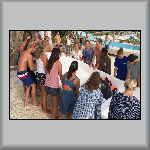 Photo MX-014 |
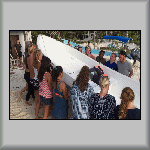 Photo MX-015 |
 Photo MX-016 |
Boat Lift and Turn (1) Video MX-001 [2 minutes, 23 seconds] |
Boat Lift and Turn (2) Video MX-002 [1 minute, 37 seconds] |
When the Wave 1 and Wave 2 teams were ready to go diving, the first boat (Hulk Kiin) was launched OK, but when it came to the second boat (Ka'ay), there was hardly enough manpower to initially move it, as can be seen in Video MX-002; on a very windy morning!
Once the boat activity had ended, I headed back to the communial area and buried my head in one of the coral books, until lunchtime (at 11:30).
I was in Wave 3, and at 12:30, started getting ready for diving. When the boats returned from the Waves 1 and 2 activities, they were anchored just off the beach. Dressed in my diving equipment (my mask around my neck, BCD and tank on my back, and weight belt around my waist) and my fins in my arms, I walked, with the other divers, down the beach and into the sea to our respective boat. The depth of water that the boats were anchored in was at about chest height (~140 cm). I would have found it easier to get (swim) to the boat if I had put my fins on my feet before the water got too deep. It wasn't easy walking through the deeper water, with the waves and currents, carrying all that equipment!
When we arrived at the boat, and before climbing aboard, we had to go through an 'undressing' procedure (to the boat captain): passing up our fins, the weight belt, and finally the BCD and tank. Only once the divers' equipment had been safely positioned in the boat, were we allowed into the boat. When one is not used to it, plus the occassional passing high wave, it is not an easy thing to do! When we were all aboard and seated, we left the beach.
However, the further we got away from the beach, the bigger the waves got! So much so, that the height of some waves were higher than the boat's canopy! At the point, Pete decided to abort the dive and we turned around and returned to the beach. Another "Boat Push" was organised, but this time to get the boats from the water and onto the beach.
An alternative action plan was swiftly arranged, and at 15:00, we all walked south along the beach for a beach clean. For those of us that were learning corals, at 16:30, Liz gave a second tutorial, this time, on the remaining coral types. Click to show/hide the second list of corals to learn!
Being Friday evening, it was the day when the staff prepare the evening
meal. Once we had all finished eating and all had been tidied up, it became
'party night', with a particular theme. It was very amusing as to what
imagination some people have! I retired at about midnight.
Saturday, 11-Mar-2017
Weekends at Pez Maya are free time for volunteers. Although we could stay at the base if we wanted to, most of the volunteers decided to go either to Tulum or Playa del Carmen. As I was new to the area, I went with the majority - to Tulum.
The taxi (Luis and his big colectivo vehicle) was booked to depart at 09:00. About an hour later, we arrived in Tulum. The first thing to do was to book accommodation for the night. We took a short walk to the Weary Traveler Hostel, situated at 36 Calle Polar Pte. Unfortunately, there wasn't enough places for all of us, so we were escorted to (what I understood to be another part of the Weary Traveler) a hostel situated between the Hotel Las Ruinas and La Nave Italian Restaurant, on Avenida Tulum. After dividing ourselves into a 'boys' room and a 'girls' room, a few of us went to get something to eat (a tuna sandwich) at a nearby Subway outlet.
There are basically three types of public road transport in the region: taxis, colectivos and buses (Autobuses de Oriente (ADO)). Taxis in Mexico, like anywhere else in the world, are the most expensive type of transport, but convenient. Colectivos (definition) are people carriers (mini-buses) that have specific local destinations; and are cheaper than taxis! In Tulum, a lot of colectivos travel between Tulum and Playa del Carmen, but to travel to other places, it is advisable to ask the driver 1) if he is going to 'such-and-such' a place, and 2) how much. The ADO network is the preferred way to travel to those places further afield; and in relative comfort. [I agree!]
After having eaten, next on the agenda was to go and visit the ancient Mayan site of Cobá; see the following four photos of parts of the site. We had to wait for the right colectivo, but eventually, one going to Cobá arrived. The fare per person was 70 MXP (£2.92).
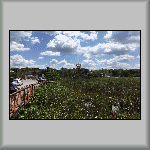 Photo MX-017 |
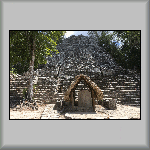 Photo MX-018 |
 Photo MX-019 |
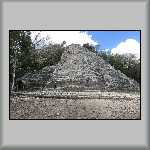 Photo MX-020 |
Back in Tulum, one of the group (John) had mislaid his bank card earlier that morning! His parents used Western Union to transfer money, but as I was the only member of the group that was carrying a passport, the transfer was in my name! John and I located the destination store, but the manager had difficulty in finding Britain/England/GB/UK from the list of countries; the closest she got was the Isle of Man! After about 15 minutes, I think she decided on specifying Mexico! Anyway, he received his money.
Stephan's parents (from Winnipeg, Canada) were on a short holiday to Tulum/Mexico. That evening, they treated the whole group to dinner at the El Mariachi Loco restauant, on Avenida Tulum; and very nice it was too!
I later returned to the hostel and read until about midnight, while others went clubbing.
| Back to Start |
 |
Next (Week 2) |
Click to reveal a QR Symbol for the Home Page
